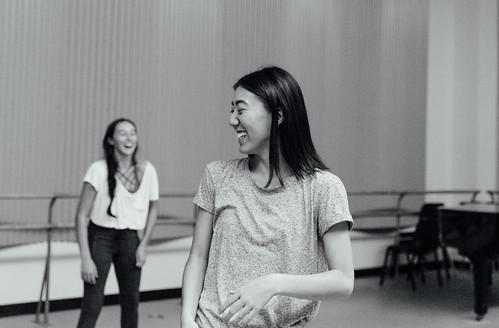Student Spotlight: Behind the Scenes of "On/Off," Choreographed by Kimie Parker Monday, November 20, 2017
In the video above, B.F.A. in dance major Kimie Parker takes you behind the scenes of "On/Off," her piece for the 2017 Student Choreography Project. Held during the fall semester, Student Choreography Project is a showcase of original choreography by the conservatory's top students.
Meet Kimie Parker
Major: B.F.A. in Dance
Graduating: Spring 2019
Hometown: San Diego, Calif.
High school: San Diego School of Creative and Performing Arts
Hobbies/interests: Music and food
What factors led you to pursue a B.F.A. in dance at Point Park University?
After an amazing six weeks at Point Park's International Summer Dance in 2014, I knew that Point Park had so much to offer. I was challenged and learned so much in a short amount of time, and could only imagine how the B.F.A. in dance program would continue to shape me as an artist. The rigorous training, spectacular dance faculty, guest artists and reputation influenced my decision. I believe that the program molds dancers into versatile and competitive artists, making it one of the best in the nation.
Tell us about "On/Off" and what inspired you to create it.
"On/Off" is a piece that began last semester in my Dance Composition class with Assistant Professor Jason McDole. Our assignment was to create a set of movements based on a prop. I chose to use a desk lamp with a movable head, allowing it to project light in any direction. I played with movement that complimented the circular shape the light projected on the floor, wall and ceiling.
After receiving positive feedback, I chose to expand my ideas into my piece for the 2017 Student Choreography Project this fall. I utilized five individual lamps on stage, one for each of my dancers. Each of them associated the light as a new world, exploring the shape, brightness and warmth. As the piece progressed, more and more light occupied the stage, causing the dancers' movements to be bigger and more explorative. This expansion of light represented a broadening of the their perspective of the world, allowing them to discover other people within the same environment. Regardless of the their costume color, each ended up fighting the exact same vulnerability and exposure to this unfamiliar environment. To me this represented how, in reality, people face similar challenges. We as humans are all the same creature enduring mental and physical barriers, as well as societal pressures. We all experience the consequences of life.
-- Garfield Lemonius
Who at Point Park helped you with your work?
My cast consisted of my peers: Shawn Cusseaux, Alexa Gajeton, Madeline Kelso, Lauren Leader, and Kaylee Wong. Jason McDole was my project mentor - who helped guide me throughout the creative process - as well as Associate Professor Garfield Lemonius.
What challenges did you face and how did you overcome them?
My main challenge was integrating dance and props. Using the lamps added a completely new dimension to the piece that held just as much (if not more) importance as the dancing. Not only did I choreograph dance movement, but I also choreographed prop movement, ultimately turning the piece into a dance between a person and light. To accomplish this, I often created visual diagrams on paper, mapping out every position change of my dancers and the lamps. My dancers' creativeness and keen awareness to detail helped make transitions efficient and seamless. It was difficult being physically incapable of doing five different roles at one time, which I'm sure is a challenge every new choreographer endures.
How have you grown as a result of this experience?
I gained a completely new perspective on the authoritative role of the choreographer. I now understand the depth in which they investigate, research and explore when creating a piece. Additionally, I have a new appreciation for the amount of time, intellectual and physical effort that goes into forming a dance with meaning, intent and substance. Most importantly, I have much more confidence as an aspiring choreographer.
What are your career goals?
I hope to join a modern or contemporary dance company and perform professionally. Throughout a performing career, I hope to choreograph, teach, collaborate with other artists and explore the world.


